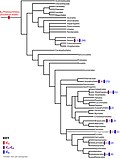The APG III system of flowering plant classification is the third version of a modern, mostly molecular-based, system of plant taxonomy being developed... 47 KB (3,194 words) - 04:17, 8 April 2024 |
 | The APG IV system of flowering plant classification is the fourth version of a modern, mostly molecular-based, system of plant taxonomy for flowering... 40 KB (2,558 words) - 13:57, 8 April 2024 |
 | Angiosperm Phylogeny Group (section APG III (2009)) angiosperm classification. As of 2016[update], three revisions have been published, in 2003 (APG II), in 2009 (APG III) and in 2016 (APG IV), each superseding... 33 KB (3,527 words) - 05:32, 8 April 2024 |
it was replaced by the improved APG II in 2003, APG III system in 2009 and APG IV system in 2016. The original APG system is unusual in being based,... 20 KB (1,429 words) - 12:57, 26 July 2023 |
 | the family Amaryllidaceae, order Asparagales. The most recent APG classification, APG III, takes a broad view of the Amaryllidaceae, which then has three... 45 KB (3,900 words) - 02:46, 8 April 2024 |
The APG II system (Angiosperm Phylogeny Group II system) of plant classification is the second, now obsolete, version of a modern, mostly molecular-based... 7 KB (650 words) - 01:27, 20 October 2022 |
Plant taxonomy (redirect from Classification of plants) t01-1-00158.x. APG (2009). "An update of the Angiosperm Phylogeny Group classification for the orders and families of flowering plants: APG III". Botanical... 14 KB (1,567 words) - 22:57, 9 May 2024 |
considered a taxon incertae sedis in the Angiosperm Phylogeny Group classification (APG III). Molecular analyses based on a recent collection from Guatemala... 4 KB (363 words) - 15:30, 17 April 2024 |
 | potentially containing one family, Dilleniaceae. The APG III system of 2009, like the earlier APG II system of 2003, left the Dilleniaceae unplaced as... 2 KB (170 words) - 03:02, 8 April 2024 |

